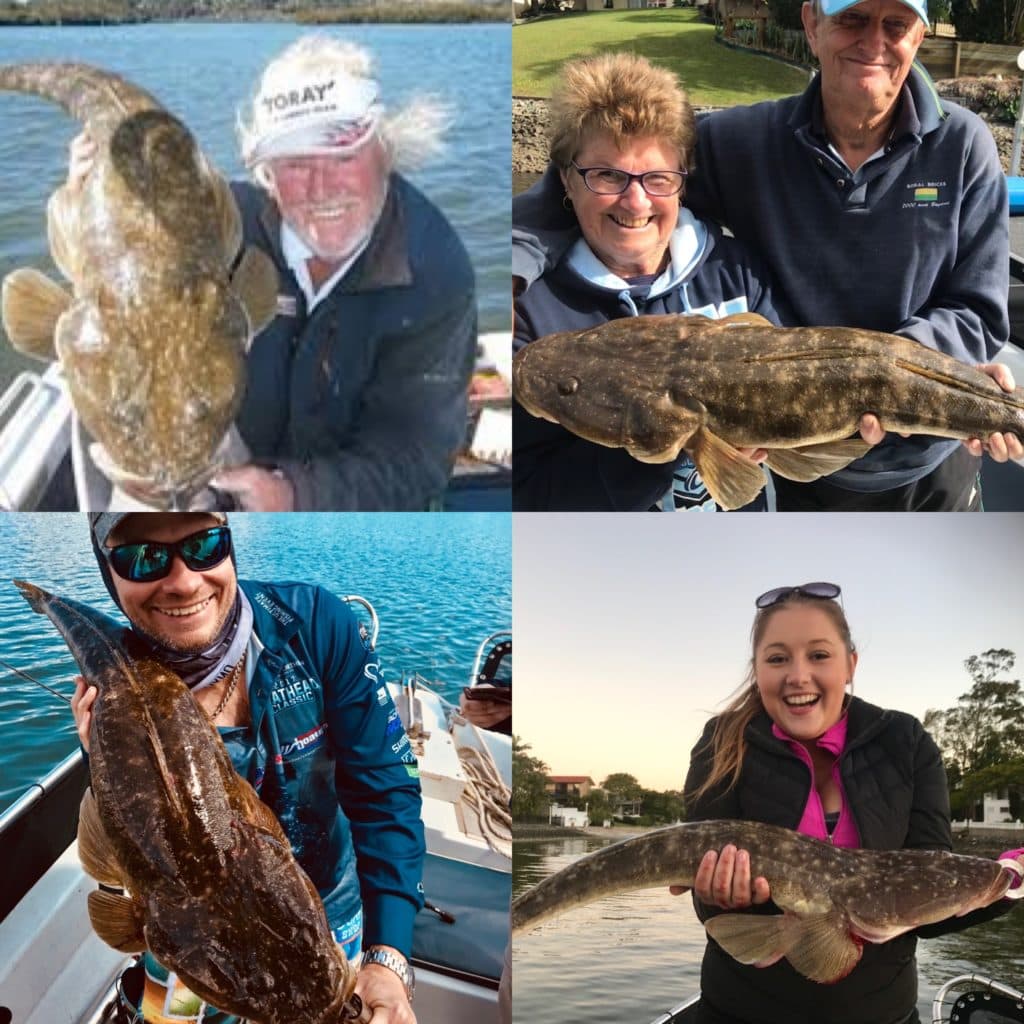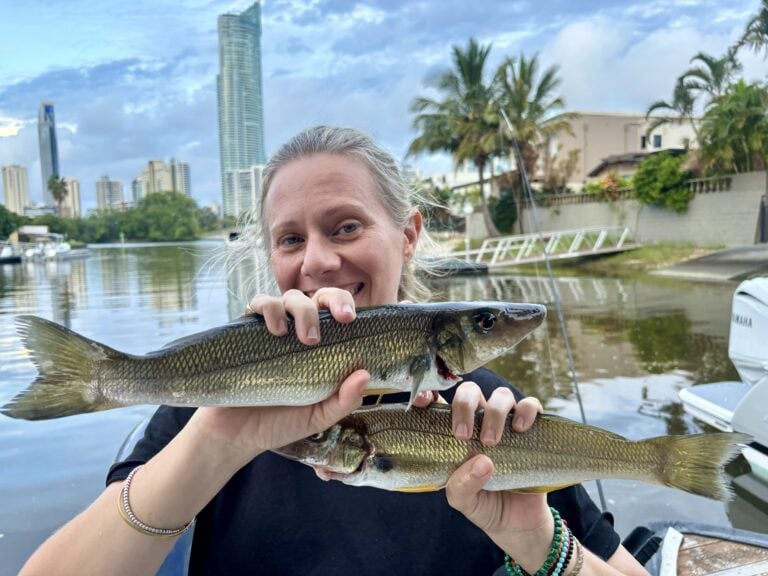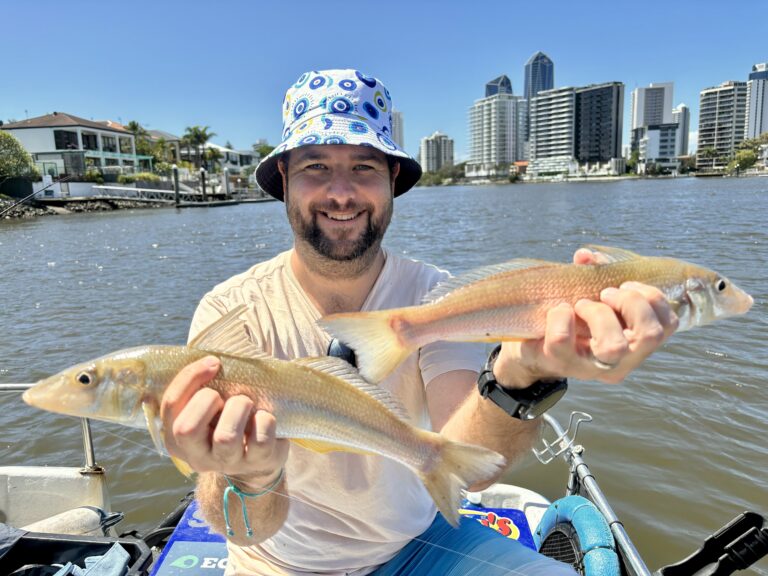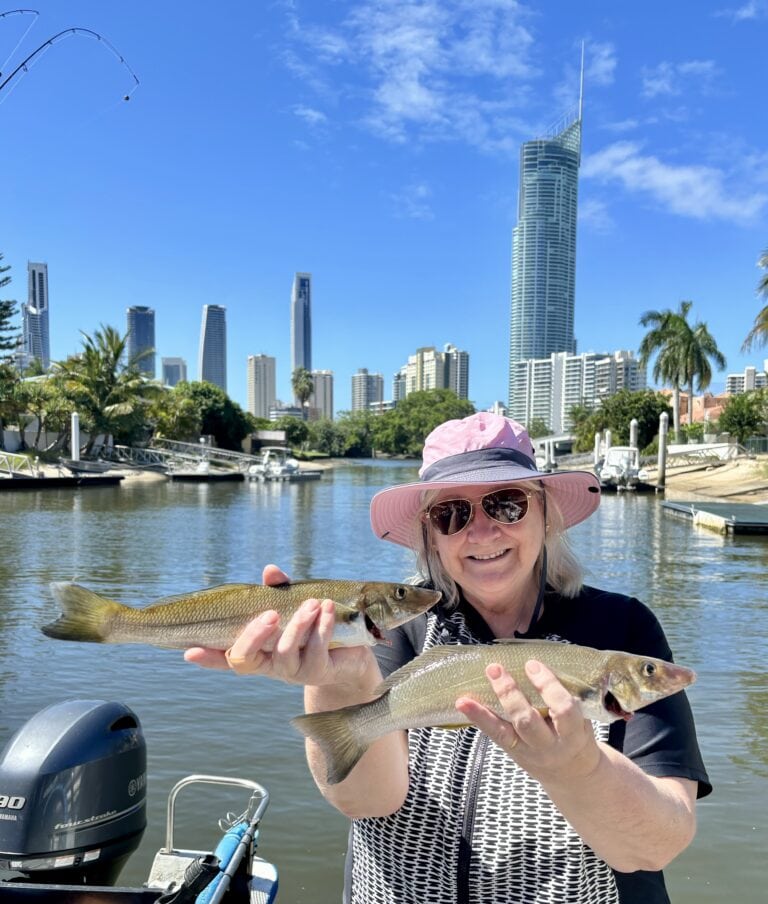FLATHEAD CLASSIC SEASON GUIDE-
Gold Coast & Jumpinpin
There are plenty of anglers who catch plenty of flathead. This article is for those who would like to improve their results using lures only, especially in the Gold Coast Flathead Classic.
Although flathead are one of the easiest fish to catch on lures, there are times when they seem surprisingly elusive to find and tempt. There are many reasons for this including water quality, amount of bait fish around, air pressure, and weather conditions.
All of these factors determine what lures and lure colours to use. One big thing to keep in mind is don’t get too distracted with changing lures too often. Keep it simple for the day, a bag full of lures on the boat can make things very confusing.
Not everyone is out to win the flathead classic, but catching fish regularly makes the days a lot more enjoyable. Hopefully this article helps! Above all, have fun and enjoy your time out there. It’s only fishing, not some super serious elite sport.
There are a vast array of lures on the market, but I will focus on which ones have the best strike rate, and are easy to use.
SOFT PLASTICS
Firstly the good old soft plastics, never a more reliable lure to use for flathead. My favourites are three and four inch paddle tail style profiles, with favourite brands being Zman, Ecogear Balt, Fish Arrow, Knockin Tail, Gobblers, Pro Lure, MMD.
Pearl/ white coloured plastics always catch lots of fish, especially in the mornings. Natural and transparent colours work well in clear water and calm, sunny conditions. Darker and gold colours in dirtier water and cloudy conditions, bright and flashy colours at times when others don’t work. Other favourite shades are motor oil, houdini, opening night, charteuse, midnight oil.
For jigheads there is none better than TT’s headlockz for soft plastics, a great allrounder is the 1/4 ounce 3/0 light guage hook for your three and four inch paddle tail plastics.
Also try to match the bait size, often you can look in the shallow water and see what it is. At the Gold Coast broadwater and Jumpinpin it is often whitebait.
Smearing scent often on plastics does not hurt at all, my favourites are the Pro Cure range and Sax scent.
Use PE 0.6 8 strand braid for main line, spooled on an Okuma 2500 size reel, and a metre of 10 lb flourocarbon leader tied with an albright knot to the braid. A 7 foot 2-4 kg rod with a medium to fast action is ideal for working plastics. We love the TT Red Belly and Black Mamba rods, and the Samaki Zing range.
Soft plastic fishing is actually very simple, with the biggest mistake many people making is moving the lure too quickly through the water. Flathead are not marlin, give them time to chase and grab!
Cast lures on top of shallow banks at run in tide, off the edges on run out tide. Find visible weedbeds with sand areas around them and you will find flathead. Always keep a look out for birds diving into the water to catch bait fish, that is a huge clue to where the flathead are hunting. Other favoured flathead haunts in shallow water are darker looking melon holes, drains, trees, muddy edges, and channel drop offs. Flathead are often feeding in very shallow areas, sometimes barely enough water to cover their backs. Always keep an eye on your fish finder as you’re drifting for patches of bait which will attract flathead. If the screen is blank keep moving.
The water is often very clear on the run in tides this time of year, until the summer rains arrive. Sometimes the water is so crystal clear that the baitfish go looking elsewhere for shelter to be less easily found and hunted. In this case go looking for slightly more discoloured water and you’ll find the flathead. Run out tides are often best for fishing as the water gets a bit dirtier.
Keep in mind that during the flathead classic there is often vast amounts of snot weed present throughout the lower estuaries. It is something you have to put up with, as there are still heaps of flathead amongst the weed. Be prepared to wind in and clear your lures of weed the second they get fouled with even the tiniest amount. Northerly winds are common this time of year too, which doesn’t make for a consistent hot bite. The fish tend to feed on and off all day so persistence is required.
These areas are best fished using spot lock on a Minn Kota electric motor. You can still fish with out an EM, but it is harder with wind and current running. Sometimes anchoring while working a spot can pay off big time. Myself and my team mate Warric finished 2nd in the two person team event in the 2021 flathead classic, the first one we’ve ever entered, without an electric motor.
Fan casts all around the boat, as soon as you get a hit keep casting in that area before you move on to the next section. The most productive technique is cast as far as you can, allow a few seconds for the plastic to sink to the bottom, then double hop the lure by lifting the rod sharply twice. Then pause, wind up the slack line, then repeat the double hop. The hits will often come on the pause so be ready to strike hard once or twice to set the hook or the flathead will spit the lure very quickly.
Mix up the speed and aggression of the lift and drops, and length of pauses, to find what works at the time.
Always check the leader after each fish, especially if they inhale the whole lure. Flathead will scuff up leaders often, and the line will break on the next bigger fish. Don’t be lazy, retie leaders as often as needed.
Bigger lures will catch bigger fish and if that’s what you are after then keep persisting. I am more on the percentage play side, where smaller lures catch all fish small and big, and you get constant action and good points in the competition.
For deeper and/ or faster flowing water heavier jigheads and bigger plastics will help reach and hold bottom when chasing the deeper crocs.
SOFT VIBES/ BLADES
We use soft vibes and blades a lot on our daily estuary charters, mainly because they catch a lot of fish! Our absolute favourite is the Samaki Vibelicious range. They have the best quality components, colours, and action of any soft vibe in the world.
They are also very easy to use, simply drop them straight to the bottom while drifting in anywhere from a metre to ten metres deep, then employ a constant tiny lift and drop with a slight pause.
This works extremely well while drifting but it is essential to move in the same direction as the tide to naturally cover ground. You will need to constantly use your outboard or electric motor to control the speed of the drift.
You can also catch and hop the soft vibes just like soft plastics. Just remember to keep the lifts really short or the treble hooks easily get caught on the leader.
If you feel the vibe is tangled on the leader or has caught a piece of weed, wind it in immediately and fix the problem. It will not get a bite while fouled.
We love the Samaki Vibelicious 70mm fork tail range but the bigger ones and the thumper tail styles also catch plenty of fish. All colours will work at times but some of our absolute favourites are pearl shrimp, whitebait, uv squid, cleopatra tiger, ghost bait, grey ghost, chartreuse ginger squid, yakka, and slimy mackerel.
As with plastics it doesn’t hurt to regularly smear a bit of scent all over the lures.
Be especially careful with handling flathead caught on the vibes. The trebles are very sticky and sharp so use long nose plyers to extract them.
Blade lures such as Ecogear ZX40’s and TT Switchblade also work extremely well on flathead and can be used just like soft vibes. Don’t be put off by their small size, we have caught many flathead from 60-90cm on these versatile lures.
Similar rod and reel set ups as plastics work well with vibes, with medium action rods best.
HARDBODY LURES:
There is a big range of lures that fall under the hardbody banner. These include minnow style ones which are killer on flathead. There are a number of ways to use them including trolling and casting.
I love casting small minnow lures over shallow flats for flathead, it is so much fun! However the most productive technique is trolling if you are serious about catching large numbers of fish.
This is most often done in depths ranging from 0.5 to four metres deep, and some of our favourite ones are Pontoon 21 crackjack 48 SP DR and Daiwa Spike 53 for up to two meters deep, and Daiwa Infeet Spike 44 xdr and Hurricane Slams for trolling up to four metres deep.
Trolling is simple but it also takes concentration to get results. Trolling speed is basically as slow as your boat can go, just in gear moving forward. Set the lures as far back as need for them to tap bottom often. This distance back ranges from 10 metres to 30 metres. As with plastics you must keep a close eye on the action of the lures by watching to see if the rod tips are vibrating. If the lures catch any weed either give the rods a firm rip to clear the weed, or if that doesn’t work then immediately wind the lure in to clean it.
Trolling is very useful on windy days over open areas, when other techniques are hard to do. Troll in the same direction as the tidal movement. You can catch a lot of fish of various sizes when trolling, and the bite can be aggressive in choppy water whipped up by wind.
6 foot 6 inch rods are ideal for trolling, and 2500 spinning reels spooled with multiple coloured PE 0.6 braid which makes it easier to measure the distance to set lures back. Use 6 to 10 lb fluorocarbon leader.
Another popular lure in recent years are the glide bait ones, some notable examples when targeting monster flathead are John Costello’s soft glide, MMD’s whiting glide, and Fish Craft’s Dr Glide.
These lures are not going to catch big numbers of flathead in a short time but it is a very exciting and visual way of fishing shallow, clear water. Cast them out and slowly retrieve and pause, watching the lure’s movement in the water to learn it’s best speed to get the best action out of it. Use a medium to heavier outfit to handle the bigger fish and strike hard to set the hooks.
For all the above lures and tackle my favourite local tackle store is Sporty’s fishing at 32 Strathaird Rd, Bundall. Their range, and friendly, expert service is awesome. Drop in there and see Tony, Tracy and the team for all your lures, soft plastics, jigheads, rods, reels, and other tackle. Tell them I sent you 😉
If you would like to learn more and see these techniques in action, get in touch to book your private lure fishing charter with us:
More info:
https://linktr.ee/goldcoastfishing
Tweed river with Brad Smith:
Call 0419 028 704
Clint at Gold Coast/ Jumpinpin:
SMS 0432 990 302
Or go to this link:
https://linktr.ee/goldcoastfishing
Charter highlights video:
Buy our books and ebooks:
Flathead lures from our store:
Thanks to our sponsors and suppliers:
Tackle Tactics
Okuma Australia
Sportys Fishing
Samaki
Gobblers Lures
JML Anglers Alliance
Ecogear Australia
Bush ‘n Beach Fishing Magazine
Step Outside With Paul Burt
Humminbird Australia & New Zealand
Stones Corner Marine
Yamaha Motor Australia
Spotters Sunglasses
Searing Tackle
Pontoon 21 lures Australia
Pro Lure Australia
MMD Fishing
SAX scent
Best spring flathead areas:
Gold Coast: yabby banks, seaway walls, crab island, currigee, runaway bay, sovereign island, aldershots
Jumpinpin:
Never fail islands, Tipplers north, Pandanus island, Gold bank, Crusoe island, Kalinga bank, jumpinpin mouth, slipping sands.
Cheers
Clint





